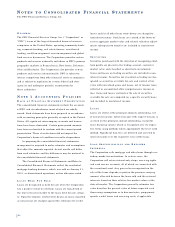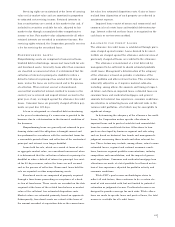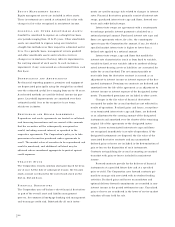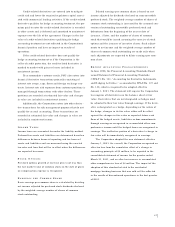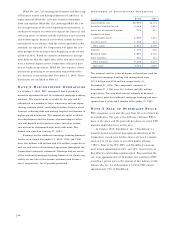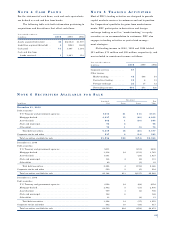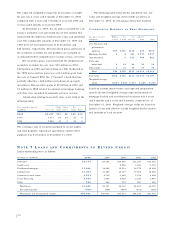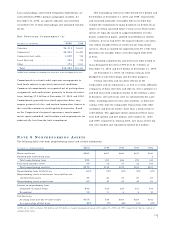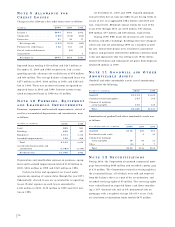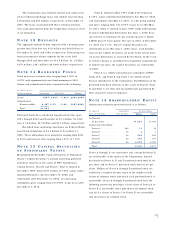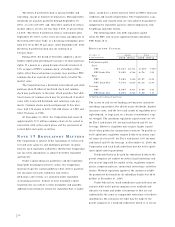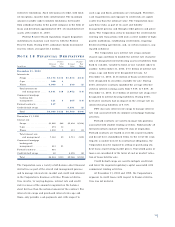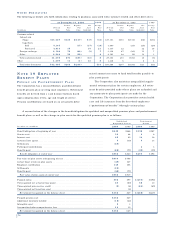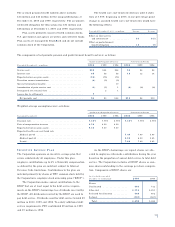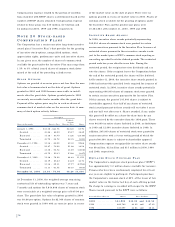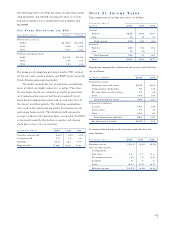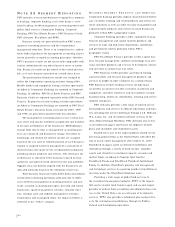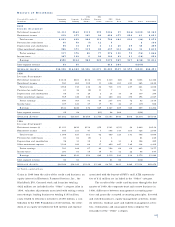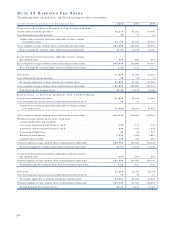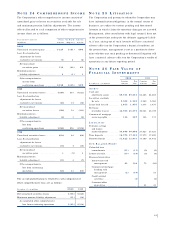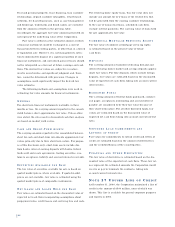PNC Bank 2000 Annual Report Download - page 77
Download and view the complete annual report
Please find page 77 of the 2000 PNC Bank annual report below. You can navigate through the pages in the report by either clicking on the pages listed below, or by using the keyword search tool below to find specific information within the annual report.
74
The Series F preferred stock is nonconvertible and
nonvoting, except in limited circumstances. Noncumulative
dividends are payable quarterly through September 30,
2001, at a rate of 6.05% and, thereafter, indexed to certain
market indices at rates not less than 6.55% or greater than
12.55% . The Series F preferred stock is redeemable until
September 29, 2001, in the event of certain amendments to
the Internal Revenue Code, at a declining redemption price
from $51.50 to $50.50 per share. After September 29, 2001,
the Series F preferred stock may be redeemed at
$50 per share.
During 2000, the board of Directors adopted a share-
holders rights plan providing for issuance of share purchase
rights. If a person or a group becomes beneficial owner of
10% or more of PNC's common stock, all holders of the
rights, other than such person or group, may purchase PNC
common stock or equivalent preferred stock at half of the
market value.
The Corporation has a dividend reinvestment and stock
purchase plan. Holders of preferred stock and common
stock may participate in the plan, which provides that addi-
tional shares of common stock may be purchased at market
value with reinvested dividends and voluntary cash pay-
ments. Common shares purchased pursuant to this plan
were: 649,334 shares in 2000, 567,266 shares in 1999 and
596,179 shares in 1998.
At December 31, 2000, the Corporation had reserved
approximately 10.9 million common shares to be issued in
connection with certain stock plans and the conversion of
certain debt and equity securities.
NO T E 1 7 RE G U L AT O R Y MAT T E R S
The Corporation is subject to the regulations of certain fed-
eral and state agencies and undergoes periodic examina-
tions by such regulatory authorities. Neither the Corporation
nor any of its subsidiaries is subject to written regulatory
agreements.
Under capital adequacy guidelines and the regulatory
framework for prompt corrective action, the Corporation
must meet specific capital guidelines that involve quantita-
tive measures of assets, liabilities and certain
off-balance-sheet items as calculated under regulatory
accounting practices. Failure to meet minimum capital
requirements can initiate certain mandatory and possibly
additional discretionary actions by regulators that, if under-
taken, could have a direct material effect on PNC’s financial
condition and results of operations. The Corporation’s capi-
tal amounts and classification are also subject to qualitative
judgments by regulatory agencies about components, risk
weightings and other factors.
The following table sets forth regulatory capital
ratios for PNC and its only significant bank subsidiary,
PNC Bank, N.A.:
RE G U L AT O R Y CA P I TA L
December 31 Amount Ratios
Dollars in millions 2000 1999 (a) 2000 1999 (a)
Risk-based capital
Tier I
PNC . . . . . . . . . $5,367 $4,731 8.60% 7.05%
PNC Bank, N.A. 5,055 4,746 8.74 7.69
Total
PNC . . . . . . . . . 7,845 7,438 12.57 11.08
PNC Bank, N.A. 7,012 6,815 12.12 11.04
Leverage
PNC . . . . . . . . . . 5,367 4,731 8.03 6.61
PNC Bank, N.A. 5,055 4,746 8.20 7.13
(a) Includes discontinued operations
The access to and cost of funding new business initiatives
including acquisitions, the ability to pay dividends, deposit
insurance costs, and the level and nature of regulatory over-
sight depend, in large part, on a financial institution’s capi-
tal strength. The minimum regulatory capital ratios are 4%
for Tier I risk-based, 8% for total risk-based and 3% for
leverage. However, regulators may require higher capital
levels when particular circumstances warrant. To qualify as
well capitalized, regulators require banks to maintain capi-
tal ratios of at least 6% for Tier I risk-based, 10% for total
risk-based and 5% for leverage. At December 31, 2000, the
Corporation and each bank subsidiary met the well capital-
ized capital ratio requirements.
Dividends that may be paid by subsidiary banks to the
parent company are subject to certain legal limitations and
also may be impacted by capital needs, regulatory require-
ments, corporate policies, contractual restrictions and other
factors. Without regulatory approval, the amount available
for payment of dividends by all subsidiary banks was $634
million at December 31, 2000.
Under federal law, bank subsidiaries generally may not
extend credit to the parent company or its nonbank sub-
sidiaries on terms and under circumstances that are not
substantially the same as comparable extensions of credit to
nonaffiliates. No extension of credit may be made to the
parent company or a nonbank subsidiary which is in excess


